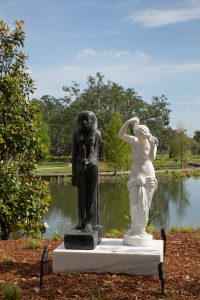
Fred Wilson (American, b. 1954), The Mete of the Muse, 2006, Bronze, paint, Gift of Sydney and Walda Besthoff, 2017.191.a,.b
American artist Fred Wilson rose to prominence in the 1980s for his work examining the politics of museum display. Wilson often mines museum archives to bring to public view objects and stories that challenge dominant cultural narratives and create space for marginalized voices and perspectives. In the 1980s, Wilson began creating a series of politically charged installations that explored how major museums and cultural institutions reflect and reinforce structural racism. In 1992, Wilson created his seminal installation Mining the Museum at the Maryland Historical Society, in which he reinstalled the museum’s permanent to collection to highlight the histories of Black and Indigenous communities in Maryland. In this and other subsequent projects, he repositioned historical objects, rewrote museum labels, and manipulated museum lighting to bring to light histories often hidden by what Wilson has called “the trompe-l’oeil of museum space.” These projects encouraged visitors to question the biases and limitations of museum display, and consider how institutional spaces like museums often shape our understanding of history and contemporary politics.
Wilson has long worked between two modes—museum interventions and creating artworks in his studio. The Mete of the Muse, located in the Besthoff Sculpture Garden, comes from a new body of work that Wilson began in the early 2000s. In this new body of large-scale sculptures, painting, installations, and performances, Wilson focuses on histories of the African diaspora, and the legacy of colonialism and slavery in the United States and around the world. The Mete of the Muse juxtaposes an ancient Egyptian female figure painted with a black patina with a figure of a Greco-Roman woman, painted white. The work reflects on commingled histories of Europe and Africa, placing works from African and European cultural lineages side by side in order to “put in relief” and highlight the systemic privileging of European history stemming from racial and cultural biases ingrained in museum display. To create this work, Wilson bought plaster cast copies of ancient sculptures and had them cast in bronze. Like the histories they represent, these copies of copies have gone through so many transitions and translations that they have become completely untethered from their original meaning and context. When Wilson presents these sculptural works, he often includes a wall label and text that simply labels them “African Figure” and “European Figure” in order to show how racial and cultural biases often create sharp divides between black and white, despite the constantly shifting narrative these sculptures represent. As Wilson says, “I find that how things shift under our noses is really fascinating.”
—Katie Pfohl, Curator of Modern and Contemporary Art
Virtual programs at NOMA are made possible in part by a major grant from the National Endowment for the Humanities. Any views, findings, conclusions, or recommendations expressed in this article do not necessarily represent those of the National Endowment for the Humanities.
NOMA is committed to uniting, inspiring, and engaging diverse communities and cultures through the arts — now more than ever. You can support NOMA’s staff during these uncertain times as they work hard to produce virtual content to keep our community connected, care for our permanent collection during the museum’s closure, and prepare to reopen our doors.
▶ DONATE NOW
